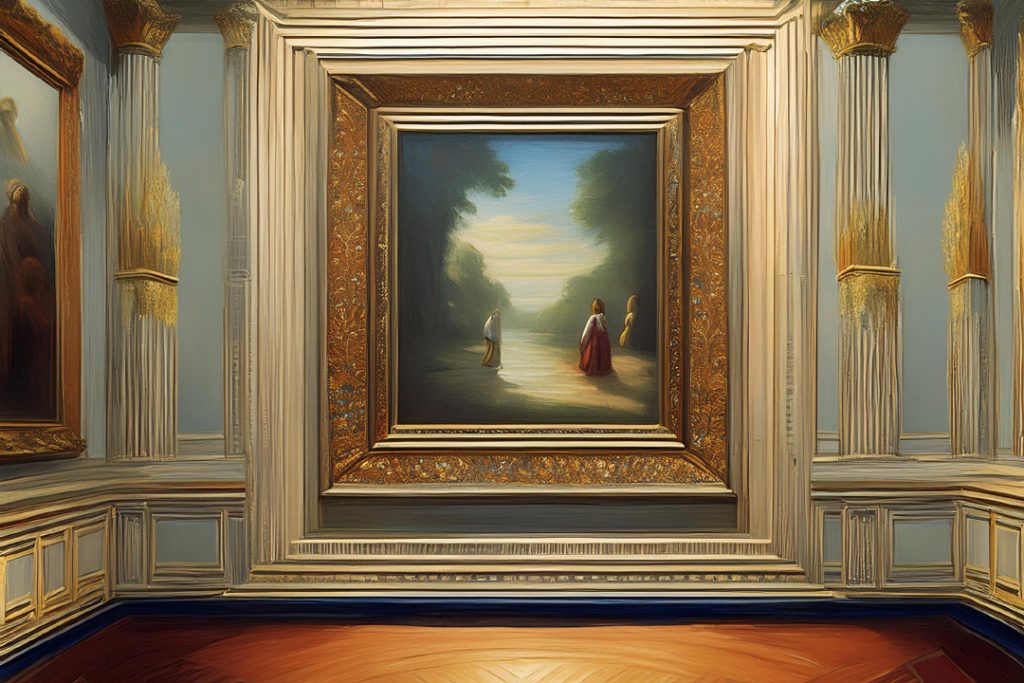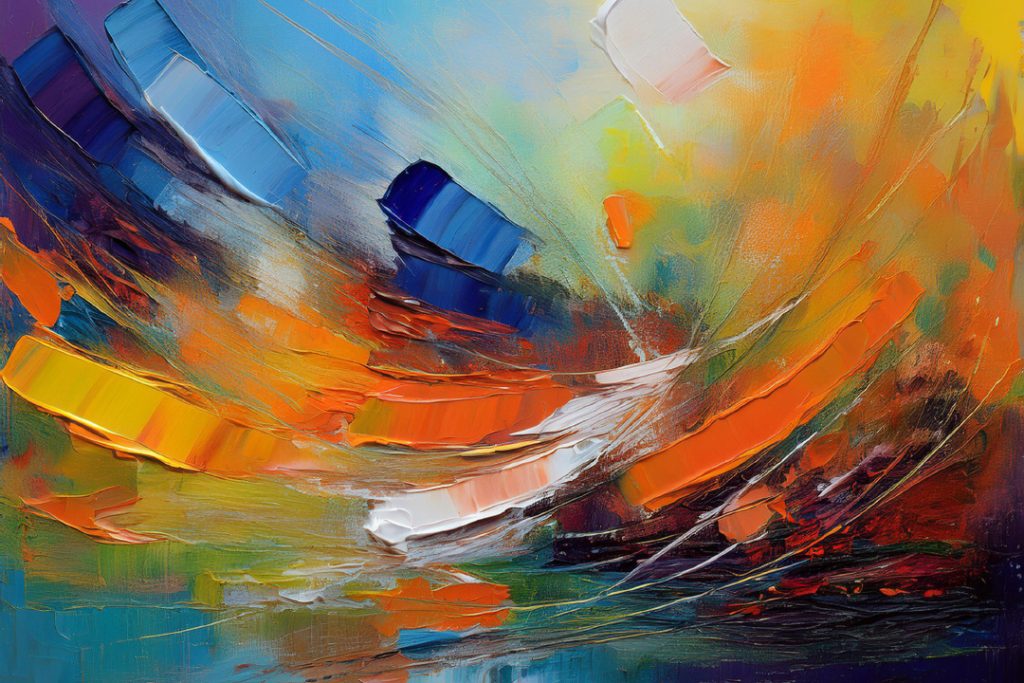The Birth of Abstract Art
Grasping where abstract art comes from is like taking a trip through the evolution of how artists express themselves in ways that go beyond the usual. Abstract art is all about breaking away from realism, diving into imagination, and stirring up emotions, marking an explosive chapter in art history.
How Abstractionism Took Shape
Abstract art didn’t just pop up; it was the rebellious kid of the early 1900s that grew out of traditional art forms like Fauvism, Cubism, and figurative expressionism. Think of artists playing around with colors, shapes, and meanings, slowly leaving behind the old constraints.
Even in the early forms like Cubism and Fauvism, there were hints of what was coming. Those movements already ditched the idea of sticking close to real-life subjects, focusing instead on the fun of bending shapes and forms. By ditching clear subjects, artists could play more with the structure and feelings in their work.
| Period | Art Movements | Cool Stuff They Did |
|---|---|---|
| Early 1900s | Fauvism, Cubism | Played with wild colors and shapes |
| 1910-1920 | Pure Abstraction | Focused on the bones of the artwork, no clear subjects |
| After 1920 | Various Trends | Mixed in cultural vibes, more non-figurative stuff |
Big Names in Abstract Art
A bunch of trailblazing artists brought abstract art to life, each with their colorful, mind-bending contributions.
- Wassily Kandinsky: The big kahuna of abstract art. Kandinsky cooked up the idea of “abstract art” in the early 20th century. His pieces are all about vibrant colors and energetic layouts, aiming to hit you right in the feels.
- Hilma af Klint: This Swedish talent only got her due after she passed away, with many claiming she was actually the first abstract artist. Her work was a mix of mysticism and science, shifting into some seriously abstract territories.
- Kazimir Malevich: This guy took “pure” abstract painting to new heights with iconic works like “Black Square,” which boiled art down to its basic shapes and forms.
- Piet Mondrian: Mondrian kept it simple and geometric, using primary colors to build his famous pieces like “Composition II in Red, Blue, and Yellow.”
- Naum Gabo: A Russian constructivist, Gabo took abstract sculpture places it had never been, mixing modern tech influences to really make his sculptures pop.
These artists showcase the vast and wild nature of abstract art, focusing on creativity and emotional punch. For more on influential artworks, peek at our collection of famous paintings in history.
These trailblazers didn’t just paint; they opened new ways of seeing and feeling the world through art, pushing boundaries and redefining creativity. So next time you’re standing in front of an abstract piece, remember, it’s more than just a painting—it’s a revolution in how we experience visual art.
Key Movements in Abstract Art
Abstract art brings out the inner wild child in artists and viewers alike. A mish-mash of bold strokes, zany colors, and forms that make you scratch your head, this art form has morphed through some seriously cool shifts over the years. Let’s chat about three head-turning movements: Abstract Expressionism, Minimalism, and Op-Art.
Abstract Expressionism
Abstract Expressionism burst onto the scene in the US right after World War II, like fireworks on a summer night. Kicking off in New York in the early ’40s, it saw artists trying to jam-pack big ideas and personal vibes into their work. Leading the charge were stars like Arshile Gorky, Jackson Pollock, Franz Kline, Mark Rothko, and Willem de Kooning (The Met, Wikipedia).
What Gave It Its Mojo?
- Surrealism: Think spontaneous, dream-like art, inspired by folks like André Masson and Max Ernst.
- Expressionism: All about raw, emotional drama.
- European Avant-garde: Sprinklings from Futurism, Bauhaus, and Synthetic Cubism.
| Artist | Key Works | Influence |
|---|---|---|
| Jackson Pollock | “No. 5, 1948” | Wild drip paintings |
| Mark Rothko | “No. 61 (Rust and Blue)” | Color Field magic |
| Willem de Kooning | “Woman I” | Bold brush strokes |
This movement was all about blowing minds with explosive techniques. Pollock’s drip paintings and Rothko’s huge swathes of color aimed to yank on heartstrings and give a sneak peek inside the artist’s mind. Wanna know more about the geniuses behind these masterpieces? Check out our section on famous paintings in history.
Minimalism and Op-Art
Minimalism
Minimalism strutted in during the late ’50s and ’60s, giving a nod to simplicity. Unlike the loud and proud Abstract Expressionism, it was about paring things down. Forget emotional messiness; this was clean, neat, and to the point. Think Donald Judd, Agnes Martin, and Frank Stella, with their crisp lines, geometric shapes, and a color palette on a diet.
| Artist | Key Works | Characteristics |
|---|---|---|
| Donald Judd | “Untitled (Stacks)” | Geometry and industrial vibes |
| Agnes Martin | “Untitled No. 5” | Whisper-soft grids |
| Frank Stella | “Die Fahne Hoch!” | Sharp and precise edges |
Minimalism’s “less is more” mantra seeped into everything from sculpture to interior design. Got a soft spot for today’s art scene? Swing by our page on contemporary sculpture artists.
Op-Art
Op-Art, short for Optical Art, sprang up in the ’60s and took eyeballs on a joyride. Digging geometric patterns and mind-bending illusions, folks like Bridget Riley and Victor Vasarely led this visual rollercoaster.
| Artist | Key Works | Characteristics |
|---|---|---|
| Bridget Riley | “Movement in Squares” | Dizzying black-and-white contrast |
| Victor Vasarely | “Zebra” | Eye-popping effects |
Op-Art enthralled viewers by tricking their eyes into seeing motion or warping shapes. This playful visual wizardry paved the way for today’s cool graphics and digital art. More into mixing it up? Don’t miss our guide on mixed media art techniques.
Wrapping It Up
Abstract art continues to breeze past the ordinary, pushing boundaries and perceptions. From the raw emotion of Abstract Expressionism to Minimalism’s less-is-more coolness and Op-Art’s optical games, these styles keep us guessing and gawking. Ready to dive in? Your art adventure awaits.
Exploring the Roots of Abstract Art
Dive into what shaped the colorful, imaginative world of abstract art. From mysticism and modernist philosophy to the Bauhaus School, these elements have been game-changers in the abstract art scene.
Mysticism and Modernist Philosophy
Mysticism and modernist philosophy were big players in abstract art’s rise. Pioneers like Wassily Kandinsky drank deep from these wells, paving the way for geometric abstraction (Wikipedia). His work often mirrored the mystical and spiritual, aiming to express raw emotions and truths with striking abstract forms.
Kandinsky saw art as a spiritual experience, which shines through in his work. His paintings pop with bold colors and dynamic patterns, crafted to spark an emotional, almost spiritual reaction. This approach was groundbreaking, encouraging others to explore complex themes through abstract art.
Modernist philosophy also lit the fuse for abstract art. It pushed artists to break free from traditional ways and explore new paths. Instead of just painting what’s physically there, they dove into abstract ideas and feelings.
| Influences on Abstract Artists | Key Contributors |
|---|---|
| Mysticism | Wassily Kandinsky |
| Modernist Philosophy | Wassily Kandinsky, Paul Klee |
Bauhaus Influence
The Bauhaus School left a huge mark on abstract art. It blended art, design, and architecture into a cohesive whole, stressing the interconnectedness of different art styles (Wikipedia). Key figures like Paul Klee and Wassily Kandinsky were instrumental in shaping its philosophy and curriculum.
Bauhaus encouraged breaking away from traditional boundaries. This experimental spirit led to new techniques and styles that enriched abstract art. Principles like balance, harmony, and simplicity were central and influenced artists to refine their work.
The Bauhaus School’s impact stretched far beyond Europe, touching artists globally. In the U.S., the influence of European modernism, championed by educators like Hans Hofmann, played a crucial role in giving birth to American Abstract Expressionism (The Metropolitan Museum of Art).
To explore more about how these movements influenced art techniques, check out our guide on mixed media art.
| Bauhaus Influence on Abstract Art | Notable Artists |
|---|---|
| Integration of Art Forms | Paul Klee, Wassily Kandinsky |
| Focus on Design Principles | Walter Gropius, László Moholy-Nagy |
Understanding these influences gives us a richer view of abstract art’s history. The mix of mysticism, modernist thought, and Bauhaus principles created fertile ground for abstract art to flourish, inspiring countless artists in its wake.
Evolution of Abstract Art
Abstract art has come a long way, brimming with creativity and reinvention. Let’s take a fun ride through how this art form has changed from the 20th century to now.
20th Century Vibes
In the early 1900s, abstract art burst forth as a radical shift from traditional art. Artists dabbled with funky shapes, bold colors, and wild lines that broke the mold. This was the beginning of abstractionism, which aimed to craft a new visual language.
Groovy Movements:
- Cubism: Pablo Picasso and Georges Braque led the charge by breaking objects into geometric shapes.
- Futurism: Emphasizing speed and tech, this movement zoomed into the modern era.
- Suprematism: Kazimir Malevich led this with basic shapes and pure artistic vibes.
- De Stijl: Piet Mondrian and others shared universal beauty through abstract forms.
Key Players and Their Magic:
| Artist | Contribution |
|---|---|
| Wassily Kandinsky | Blazed trails as a pioneer of abstract art. |
| Kazimir Malevich | Kickstarted Suprematism. |
| Piet Mondrian | Brought us the beauty of De Stijl. |
The latter half of the century saw abstract expressionism take off with explosive creativity, thanks to folks like Jackson Pollock and Mark Rothko. Their spontaneous creation made the U.S. a hotspot for avant-garde abstract art.
Abstract Art in the 21st Century
As we crossed into the new millennium, abstract art morphed into even more exciting forms. New genres keep popping up, making sure the abstract scene stays fresh and lively.
Modern Flavors:
- Digital Art: Artists use tech to craft digital masterpieces.
- Hard-Edge Painting: Known for sharp, clean edges between colors.
- Geometric Abstraction: All about simple shapes.
- Minimalism: Gets down to the basics.
- Op Art: Fun optical illusions to trick your eye.
- Lyrical Abstraction: Flows with emotion and vibrant hues.
| Movement | What It’s All About |
|---|---|
| Digital Art | Mixing digital tech with artistic flair. |
| Hard-Edge | Crisp, sharp lines and clean color splits. |
| Geometric | Simple shapes creating stunning designs. |
| Minimalism | Keeping it super simple. |
| Op Art | Playing with optical tricks and illusions. |
| Lyrical | Free-wheeling with color and emotion. |
Today’s artists are always coming up with new tricks by blending old-school methods with cutting-edge tech. This nonstop innovation keeps abstract art exciting and meaningful.
For more cool reads, check out our deep dives into famous paintings in history and mixed media art techniques. Explore the awesome ways visual arts have evolved over time.
The Impact of Abstract Expressionism
What Makes Abstract Expressionism Special
Rise and shine in the early 1940s New York, Abstract Expressionism burst onto the scene with flair. It grabbed ideas from Surrealists like André Masson and Max Ernst, blending the emotional oomph of German Expressionism with the edgy vibes of European avant-garde crews like Futurism, Bauhaus, and Cubism (Wikipedia).
So, what makes it tick? Here’s the lowdown:
- Go With the Flow: Artists basically said, “Let’s wing it!” and splashed, dripped, and smeared paint all over. This technique, dubbed “action painting,” got immortalized by Jackson Pollock. It’s like watching raw emotion drip onto the canvas.
- Think Big: Forget tiny paintings. These canvases are huge, luring you into their whirlwind of colors and forms.
- Heart on Sleeve: Inspired by personal demons and the scars of war, works from folks like Willem de Kooning and Franz Kline scream with emotional intensity.
- Mystery Shapes: Recognizable shapes? Nah. They ditched reality to mess around with color, line, and texture, betting on triggering feelings over telling a story.
Going Global with Abstract Expressionism
Abstract Expressionism isn’t just a funky American fling; it’s the first US art movement to wow the world. This craze flipped the art world’s focus from Europe to New York, making it the new must-be spot for postwar art (The Metropolitan Museum of Art).
Let’s see how it shook things up:
- Rebel Yell: The movement’s edgy, non-conformist vibe lit a fire in artists everywhere, sparking a tsunami of creativity.
- Mixing it Up: It was a grab-bag of styles, pushing everyone to experiment. This melting pot brought out wild interpretations and new artistic paths globally.
- Stars and Critics: Heavyweights like Jackson Pollock got equal parts applause and eyebrow-raising. Critics Clement Greenberg and Harold Rosenberg were the hype-men of the scene.
- War’s Wake: Those powerhouse meet-ups with European artists during WWII brought fresh ideas. Techniques like psychic automatism shook things up, urging artists to dig deep into their subconscious (The Metropolitan Museum of Art).
| Artist | What They Did Best |
|---|---|
| Jackson Pollock | Mastered “action painting” with wild, spontaneous splashes. |
| Willem de Kooning | Made huge, emotionally-charged abstract pieces. |
| Franz Kline | Loved those bold, sweeping black and white strokes. |
| Lee Krasner | Mixed Surrealist techniques for powerful, personal art. |
| Robert Motherwell | Married European modernism with raw emotion. |
Dying to learn more about these legends? Check our full scoop on famous paintings in history. Abstract Expressionism paved the way for many artistic offshoots, leaving a massive footprint on modern and contemporary art.
Feelings and Perspectives
Open to Your Eyes
Abstract art flips the script on traditional art, pushing you to explore new vibes and feelings. You won’t find apples that look like apples here. Abstract artists ditch the whole realistic scene thing for something more personal. Through the magic of symbols and lines, they can conjure up feelings ranging from cozy and warm to bold and mighty. It’s all about what you see and feel.
Geometric abstraction zeroes in on basic shapes—think circles, squares, and triangles. Forget the natural world. Here, you are free to dream up your own meanings. The gap between what the artist imagines and what you perceive is your playground. For more tips on brushing up your artistic skills, check out our article on beginner’s painting techniques.
| Element | What It Feels Like |
|---|---|
| Curved Lines | Cozy, Comfy |
| Straight Lines | Strong, Powerful |
| Basic Shapes | Simple, Ordered |
| Freeform Shapes | Limitless, Imaginative |
What Abstract Art Makes You Feel
Abstract art isn’t just about colors and shapes—it’s a ticket to a personal emotional roller coaster. Starting out in the early 1900s, the movement has used shapes, hues, and dynamic lines to create a visual language that connects on an emotional level, skipping the obvious imagery.
Artists like Wassily Kandinsky, Piet Mondrian, Jackson Pollock, and Helen Frankenthaler are big names in this game, turning heads with pieces like Kandinsky’s “Untitled,” Mondrian’s simple yet striking “Tableau,” Pollock’s wild “Full Fathom Five,” and Frankenthaler’s dreamy “Mountains and Sea.”
The use of lively or muted colors, unique forms, and textured details invites you on an emotional adventure through each artwork. Dive into our article on mixed media art techniques for more on how different textures and materials amp up the emotional punch.
Abstract art’s magic lies in its ability to tug different strings for different folks. Whether it sends your heart racing or lifts you into a Zen-like calm, the journey is deeply personal and keeps abstract art fresh and popular.
| Artist | Standout Piece | Feels Like |
|---|---|---|
| Wassily Kandinsky | “Untitled” | Wild, Chaotic |
| Piet Mondrian | “Tableau” | Neat, Peaceful |
| Jackson Pollock | “Full Fathom Five” | Thrilling, Intense |
| Helen Frankenthaler | “Mountains and Sea” | Calming, Thoughtful |
Getting a grasp on how abstract art rocks your perception and emotion amps up your appreciation of its power. For more arty goodness, check out our sections on famous paintings through history and modern sculpting superstars.
Here some recommended links selected for you: The Best Books of the Month, Todays best Deals at Amazon, Best Sellers in Cell Phones & Accessories and last but not least the easy and great way to send a gift for the holidays: Amazon.com eGift Card (Instant Email or Text Delivery).




